Abstract
Antigen opsonization by the C3b fragment of complement is a significant event in the modulation of cell-mediated immune response, but its mechanism is still largely unknown. The structural characteristics of C3b allow it to act as a bifunctional ligand between antigen and cells via their membrane C3b receptors. It was thus of interest to study the influence of the covalent link between C3b and antigen on the fixation and internalization of this antigen by antigen-presenting cells. Tetanus toxin (TT) was used as antigen, either free or covalently linked to C3b (TT-C3b). The antigen-presenting cells were TT-specific (4.2) or non-specific (BL15) Epstein-Barr virus (EBV)-transformed B cells. C3b was found to play an important role in antigen fixation and internalization by both antigen-specific and antigen non-specific cells. Covalent binding of C3b on TT (1) permitted fixation and internalization of this antigen by non-specific cells via their complement receptors; (2) enhanced antigen fixation and resulted in cross-linking between membrane immunoglobulins and complement receptors on antigen-specific cells. The consequences of covalent C3b binding to TT were analysed using antigen-specific and antigen-nonspecific cells. In both cases, a net increase in antigen fixation was observed. At the intracellular level, covalent C3b binding to TT resulted in a large TT incorporation in endosomes of nonspecific cells, similar to that observed in antigen-specific cells. Thus, C3b covalently linked to antigen enlarges the array of B-cell types capable of presenting antigen, including non-specific cells.
Full text
PDF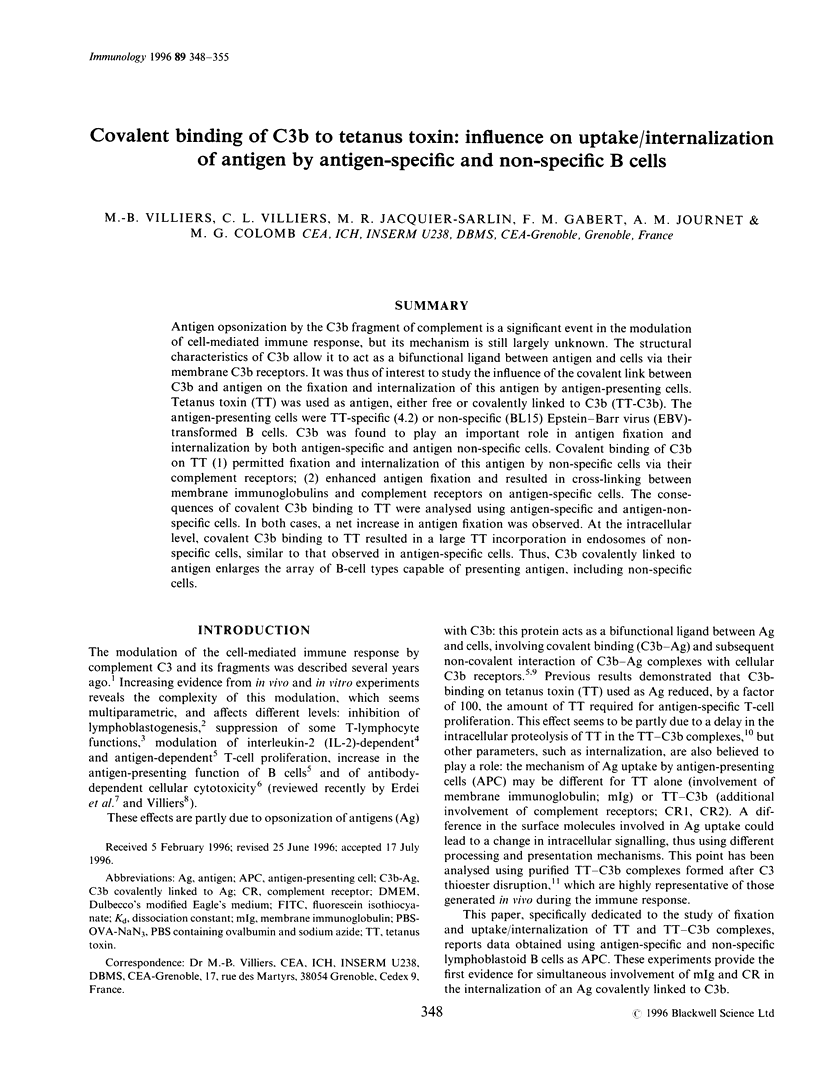

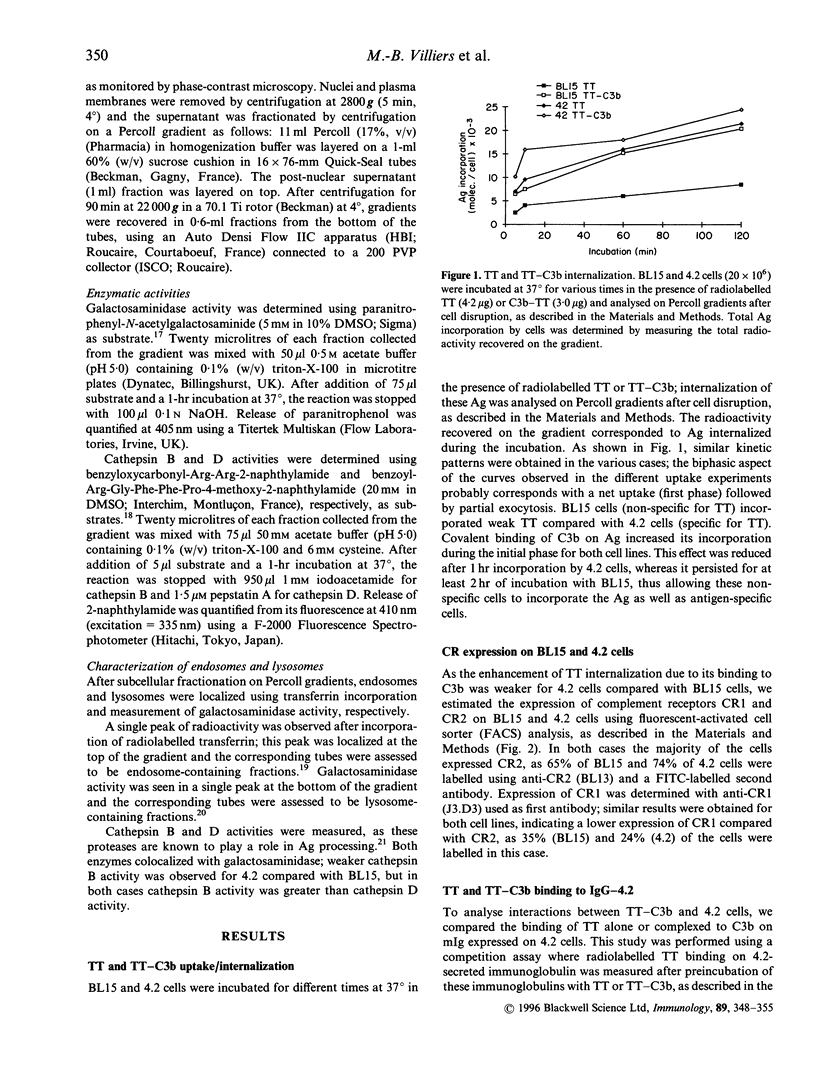
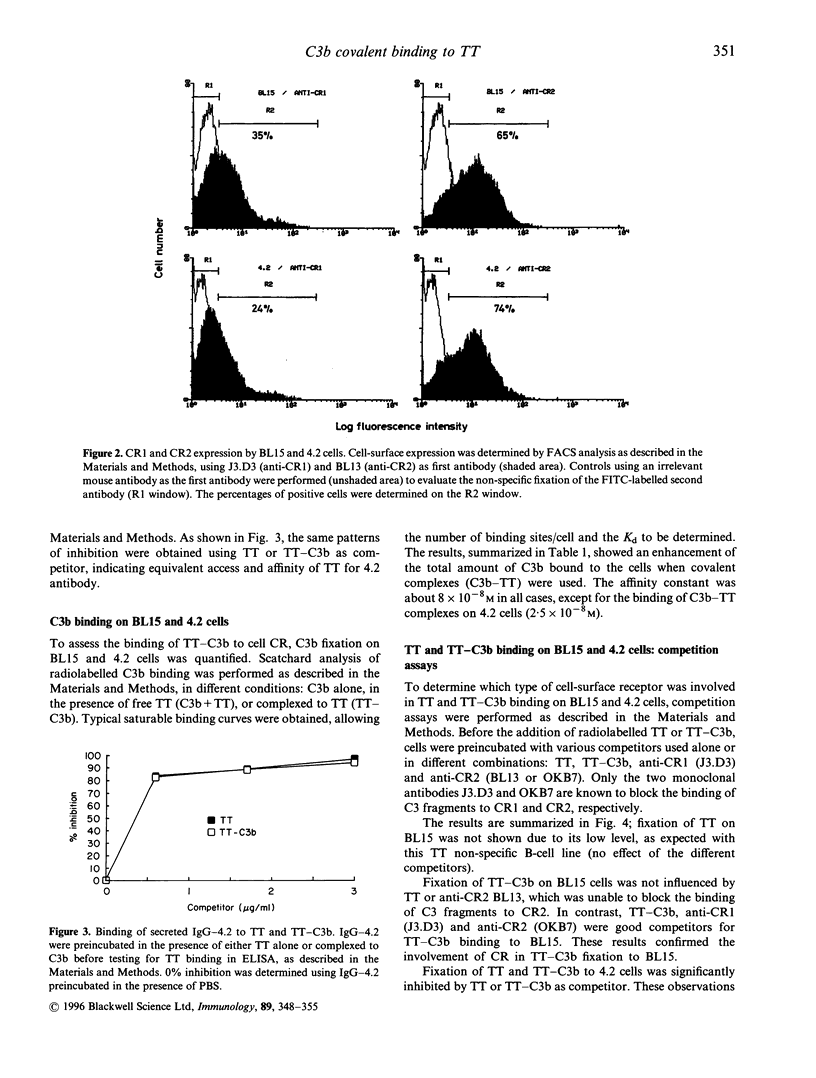
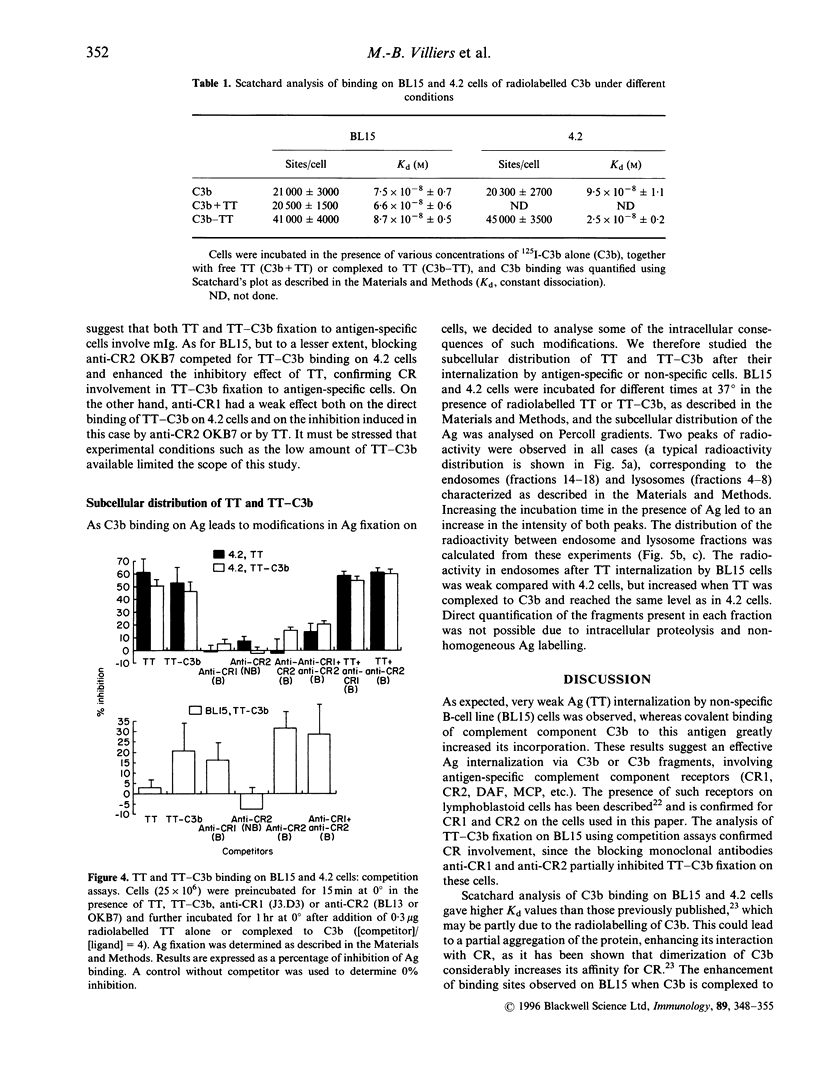
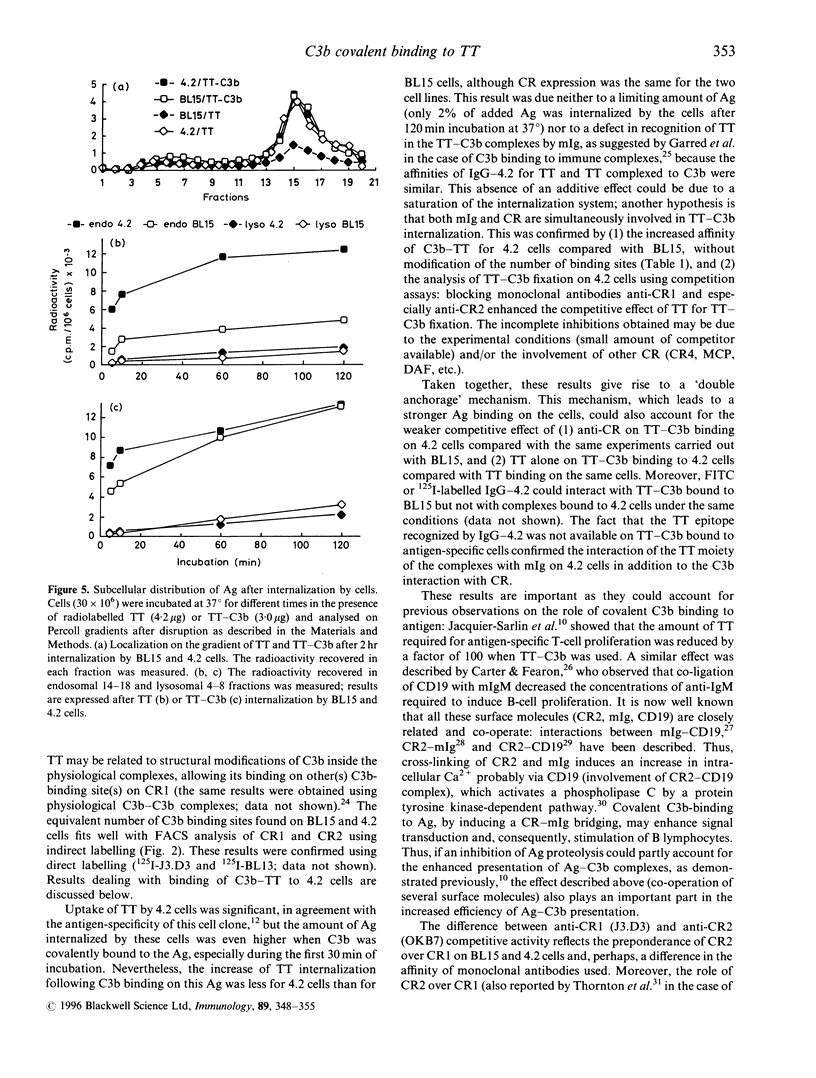
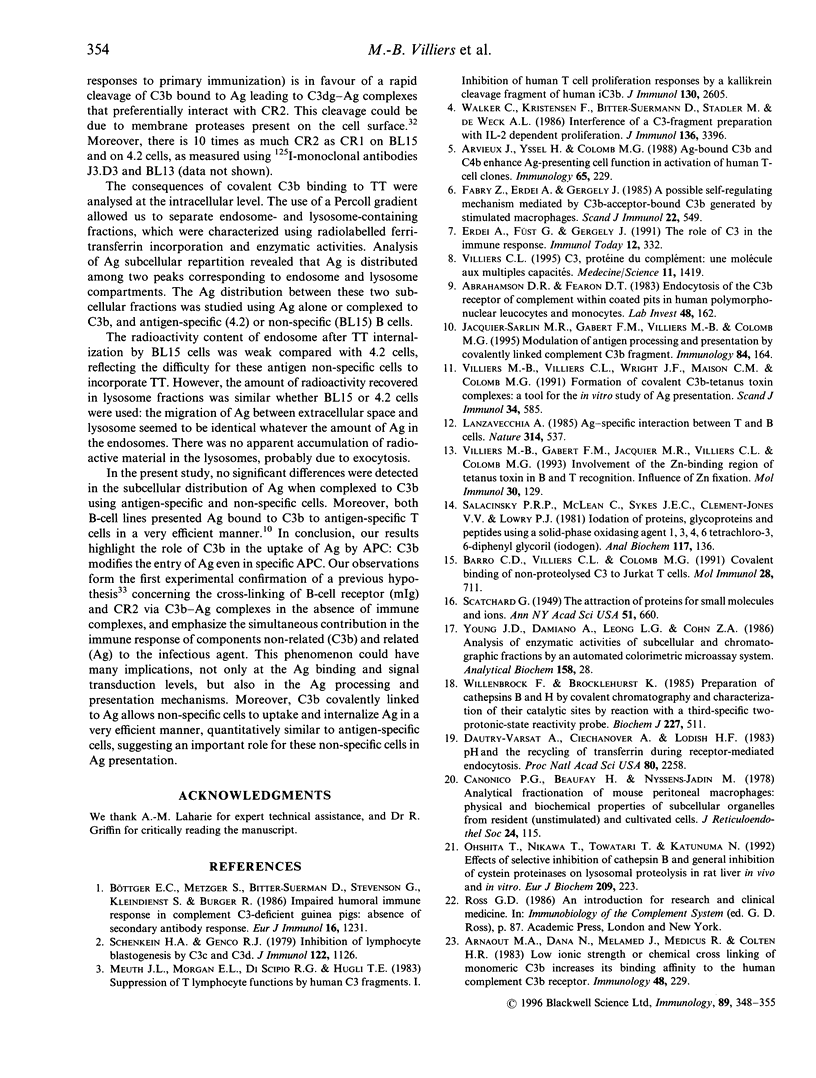
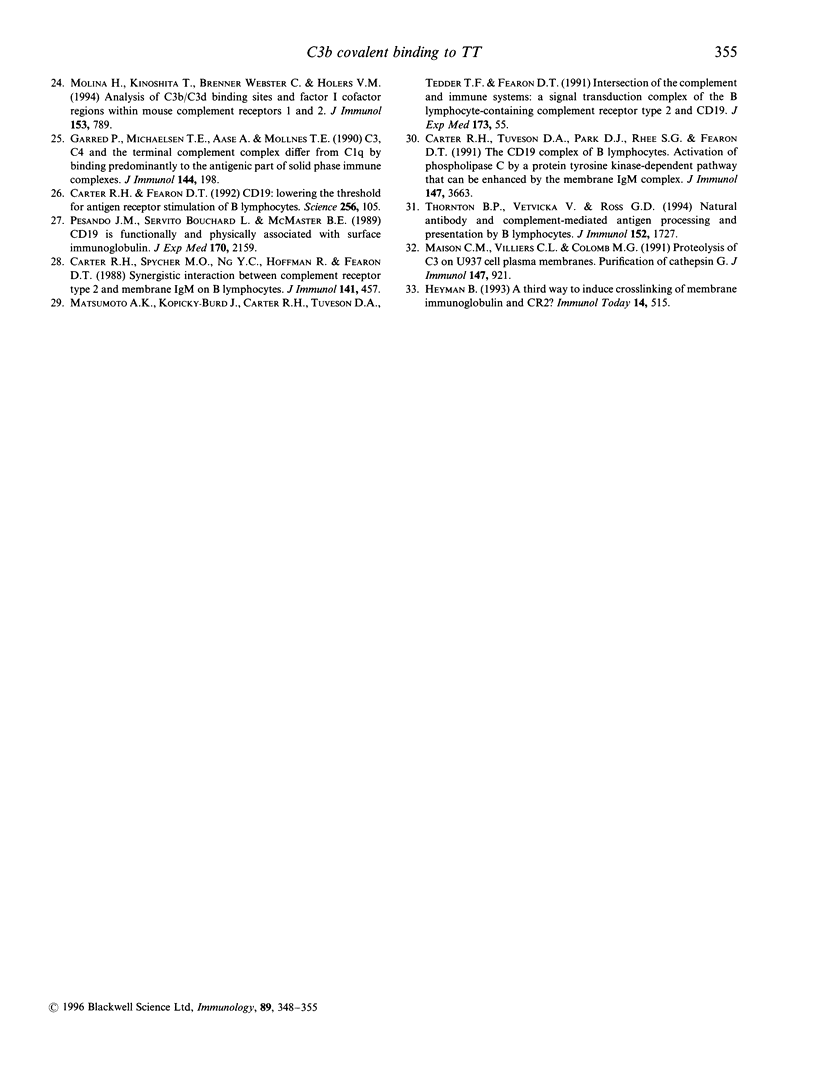
Images in this article
Selected References
These references are in PubMed. This may not be the complete list of references from this article.
- Abrahamson D. R., Fearon D. T. Endocytosis of the C3b receptor of complement within coated pits in human polymorphonuclear leukocytes and monocytes. Lab Invest. 1983 Feb;48(2):162–168. [PubMed] [Google Scholar]
- Arnaout M. A., Dana N., Melamed J., Medicus R., Colten H. R. Low ionic strength or chemical cross-linking of monomeric C3b increases its binding affinity to the human complement C3b receptor. Immunology. 1983 Feb;48(2):229–237. [PMC free article] [PubMed] [Google Scholar]
- Arvieux J., Yssel H., Colomb M. G. Antigen-bound C3b and C4b enhance antigen-presenting cell function in activation of human T-cell clones. Immunology. 1988 Oct;65(2):229–235. [PMC free article] [PubMed] [Google Scholar]
- Barro C. D., Villiers C. L., Colomb M. G. Covalent binding of non-proteolysed C3 to Jurkat T cells. Mol Immunol. 1991 Jul;28(7):711–717. doi: 10.1016/0161-5890(91)90113-x. [DOI] [PubMed] [Google Scholar]
- Böttger E. C., Metzger S., Bitter-Suermann D., Stevenson G., Kleindienst S., Burger R. Impaired humoral immune response in complement C3-deficient guinea pigs: absence of secondary antibody response. Eur J Immunol. 1986 Oct;16(10):1231–1235. doi: 10.1002/eji.1830161008. [DOI] [PubMed] [Google Scholar]
- Canonico P. G., Beaufay H., Nyssens-Jadin M. Analytical fractionation of mouse peritoneal macrophages: physical and biochemical properties of subcellular organelles from resident (unstimulated) and cultivated cells. J Reticuloendothel Soc. 1978 Aug;24(2):115–138. [PubMed] [Google Scholar]
- Carter R. H., Fearon D. T. CD19: lowering the threshold for antigen receptor stimulation of B lymphocytes. Science. 1992 Apr 3;256(5053):105–107. doi: 10.1126/science.1373518. [DOI] [PubMed] [Google Scholar]
- Carter R. H., Spycher M. O., Ng Y. C., Hoffman R., Fearon D. T. Synergistic interaction between complement receptor type 2 and membrane IgM on B lymphocytes. J Immunol. 1988 Jul 15;141(2):457–463. [PubMed] [Google Scholar]
- Carter R. H., Tuveson D. A., Park D. J., Rhee S. G., Fearon D. T. The CD19 complex of B lymphocytes. Activation of phospholipase C by a protein tyrosine kinase-dependent pathway that can be enhanced by the membrane IgM complex. J Immunol. 1991 Dec 1;147(11):3663–3671. [PubMed] [Google Scholar]
- Dautry-Varsat A., Ciechanover A., Lodish H. F. pH and the recycling of transferrin during receptor-mediated endocytosis. Proc Natl Acad Sci U S A. 1983 Apr;80(8):2258–2262. doi: 10.1073/pnas.80.8.2258. [DOI] [PMC free article] [PubMed] [Google Scholar]
- Erdei A., Füst G., Gergely J. The role of C3 in the immune response. Immunol Today. 1991 Sep;12(9):332–337. doi: 10.1016/0167-5699(91)90011-H. [DOI] [PubMed] [Google Scholar]
- Fábry Z., Erdei A., Gergely J. A possible self-regulating mechanism mediated by C3b-acceptor-bound C3b generated by stimulated macrophages. Scand J Immunol. 1985 Nov;22(5):549–555. doi: 10.1111/j.1365-3083.1985.tb01914.x. [DOI] [PubMed] [Google Scholar]
- Garred P., Michaelsen T. E., Aase A., Mollnes T. E. C3, C4, and the terminal complement complex differ from C1q by binding predominantly to the antigenic part of solid phase immune complexes. J Immunol. 1990 Jan 1;144(1):198–203. [PubMed] [Google Scholar]
- Heyman B. A third way to induce crosslinking of membrane immunoglobulin and CR2? Immunol Today. 1993 Oct;14(10):515–515. doi: 10.1016/0167-5699(93)90269-Q. [DOI] [PubMed] [Google Scholar]
- Jacquier-Sarlin M. R., Gabert F. M., Villiers M. B., Colomb M. G. Modulation of antigen processing and presentation by covalently linked complement C3b fragment. Immunology. 1995 Jan;84(1):164–170. [PMC free article] [PubMed] [Google Scholar]
- Lanzavecchia A. Antigen-specific interaction between T and B cells. Nature. 1985 Apr 11;314(6011):537–539. doi: 10.1038/314537a0. [DOI] [PubMed] [Google Scholar]
- Maison C. M., Villiers C. L., Colomb M. G. Proteolysis of C3 on U937 cell plasma membranes. Purification of cathepsin G. J Immunol. 1991 Aug 1;147(3):921–926. [PubMed] [Google Scholar]
- Matsumoto A. K., Kopicky-Burd J., Carter R. H., Tuveson D. A., Tedder T. F., Fearon D. T. Intersection of the complement and immune systems: a signal transduction complex of the B lymphocyte-containing complement receptor type 2 and CD19. J Exp Med. 1991 Jan 1;173(1):55–64. doi: 10.1084/jem.173.1.55. [DOI] [PMC free article] [PubMed] [Google Scholar]
- Meuth J. L., Morgan E. L., DiSipio R. G., Hugli T. E. Suppression of T lymphocyte functions by human C3 fragments. I. Inhibition of human T cell proliferative responses by a kallikrein cleavage fragment of human iC3b. J Immunol. 1983 Jun;130(6):2605–2611. [PubMed] [Google Scholar]
- Molina H., Kinoshita T., Webster C. B., Holers V. M. Analysis of C3b/C3d binding sites and factor I cofactor regions within mouse complement receptors 1 and 2. J Immunol. 1994 Jul 15;153(2):789–795. [PubMed] [Google Scholar]
- Ohshita T., Nikawa T., Towatari T., Katunuma N. Effects of selective inhibition of cathepsin B and general inhibition of cysteine proteinases on lysosomal proteolysis in rat liver in vivo and in vitro. Eur J Biochem. 1992 Oct 1;209(1):223–231. doi: 10.1111/j.1432-1033.1992.tb17280.x. [DOI] [PubMed] [Google Scholar]
- Pesando J. M., Bouchard L. S., McMaster B. E. CD19 is functionally and physically associated with surface immunoglobulin. J Exp Med. 1989 Dec 1;170(6):2159–2164. doi: 10.1084/jem.170.6.2159. [DOI] [PMC free article] [PubMed] [Google Scholar]
- Salacinski P. R., McLean C., Sykes J. E., Clement-Jones V. V., Lowry P. J. Iodination of proteins, glycoproteins, and peptides using a solid-phase oxidizing agent, 1,3,4,6-tetrachloro-3 alpha,6 alpha-diphenyl glycoluril (Iodogen). Anal Biochem. 1981 Oct;117(1):136–146. doi: 10.1016/0003-2697(81)90703-x. [DOI] [PubMed] [Google Scholar]
- Schenkein H. A., Genco R. J. Inhibition of lymphocyte blastogenesis by C3c and C3d. J Immunol. 1979 Mar;122(3):1126–1133. [PubMed] [Google Scholar]
- Thornton B. P., Vetvicka V., Ross G. D. Natural antibody and complement-mediated antigen processing and presentation by B lymphocytes. J Immunol. 1994 Feb 15;152(4):1727–1737. [PubMed] [Google Scholar]
- Villiers M. B., Gabert F. M., Jacquier M. R., Villiers C. L., Colomb M. G. Involvement of the Zn-binding region of tetanus toxin in B and T recognition. Influence of Zn fixation. Mol Immunol. 1993 Feb;30(2):129–136. doi: 10.1016/0161-5890(93)90084-o. [DOI] [PubMed] [Google Scholar]
- Villiers M. B., Villiers C. L., Wright J. F., Maison C. M., Colomb M. G. Formation of covalent C3b-tetanus toxin complexes: a tool for the in vitro study of antigen presentation. Scand J Immunol. 1991 Nov;34(5):585–595. doi: 10.1111/j.1365-3083.1991.tb01582.x. [DOI] [PubMed] [Google Scholar]
- Walker C., Kristensen F., Bitter-Suermann D., Stadler B. M., de Weck A. L. Interference of a C3-fragment preparation with IL 2-dependent proliferation. J Immunol. 1986 May 1;136(9):3396–3401. [PubMed] [Google Scholar]
- Willenbrock F., Brocklehurst K. Preparation of cathepsins B and H by covalent chromatography and characterization of their catalytic sites by reaction with a thiol-specific two-protonic-state reactivity probe. Kinetic study of cathepsins B and H extending into alkaline media and a rapid spectroscopic titration of cathepsin H at pH 3-4. Biochem J. 1985 Apr 15;227(2):511–519. doi: 10.1042/bj2270511. [DOI] [PMC free article] [PubMed] [Google Scholar]
- Young J. D., Damiano A., Leong L. G., Cohn Z. A. Analysis of enzymatic activities of subcellular and chromatographic fractions by an automated colorimetric microassay system. Anal Biochem. 1986 Oct;158(1):28–35. doi: 10.1016/0003-2697(86)90583-x. [DOI] [PubMed] [Google Scholar]



